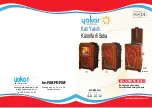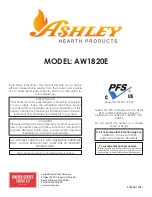
© 2007-2008 Broseley Fires Ltd
CLOSED
OPEN
4D
Direct
Flue
Path
Shutter
Control
(lever
C)
This
control
is
used
to
bypass
the
baffle
within
the
stove
when
there
is
a
risk
of
the
chimney
being
cold
and
therefore
generating
little
draw;
when
the
stove
has
not
been
lit
for
some
time
for
example.
The
flue
may
need
a
little
assistance
and
therefore,
if
the
shutter
is
opened
before
the
fire
is
lit;
the
warm/hot
gasses
from
the
fire
will
not
have
to
travel
around
the
baffle,
losing
heat
as
they
go.
They
can
go
directly
into
the
chimney
where
they
will
heat
the
chimney
and
thus
generate
a
good
flue
draft.
5.
FUEL
OPTIONS
These
appliances
have
been
designed
to
burn
wood
as
their
primary
fuel
source.
Do
not
burn
wood
that
contains
chemicals
(e.g.
paint
and
glue)
You
need
to
use
well
seasoned
wood
to
get
the
best
results
from
your
stove,
logs
should
have
a
moisture
content
of
less
than
20%.
5A
BURNING
WOOD
Hardwoods
and
softwoods
both
have
the
same
calorific
value
(by
weight),
however
softwoods
will
burn
nearly
twice
as
fast
as
hardwoods.
Most
firewood
you
purchase
will
be
green
and
have
a
fair
amount
of
water
content.
It
will
need
to
be
stored
in
a
well
ventilated
shelter
to
season
it.
Wood
used
in
this
appliance
must
have
a
moisture
content
of
less
than
20%.
Damp
or
wet
wood
will
quickly
form
tar
deposits
on
all
the
internal
areas
where
the
combustible
gasses
travel.
They
will
coat
the
chimney/flue
with
tar
and
soot
therefore
increasing
the
risk
of
a
chimney
fire..
Always
use
good
quality
wood,
store
it
under
cover
in
a
well
ventilated
area.
Avoid
burning
oak
bark,
as
this
forms
tar
at
a
very
fast
rate.
When
selecting
wood,
also
take
into
consideration
ease
of
splitting,
ease
of
ignition
and
burning,
how
much
smoke
it
produces
and
its
"coaling"
qualities.
"Coaling"
refers
to
the
ability
of
a
species
of
wood
to
form
a
long
‐
lasting
bed
of
hot
coals
when
burned.
Coaling
qualities
improve
with
higher
density.
5C
Hot
Plate
Operation
To
operate
your
hot
plate
on
your
stove
lift
the
hot
plate
cover
upwards,
always
using
the
glove
supplied,
until
the
catch
at
the
rear
is
locked
into
place,
to
prevent
the
cover
from
falling.
To
lower
the
hot
plate,
release
the
catch
(using
the
tool
supplied)
and
slowly
lower
the
hot
plate
cover
back
into
place,
using
the
glove
supplied.
Familiarise
your
self
with
this
operation
whilst
the
stove
is
cold.


































